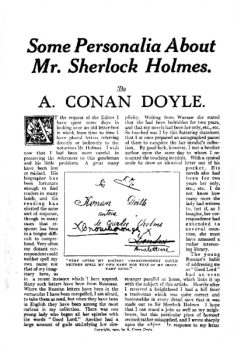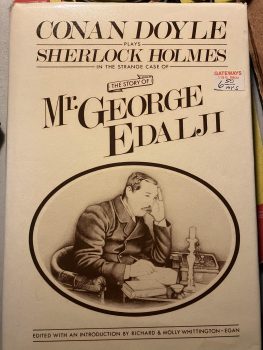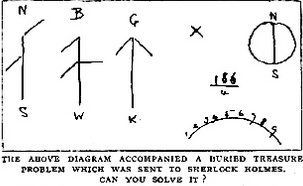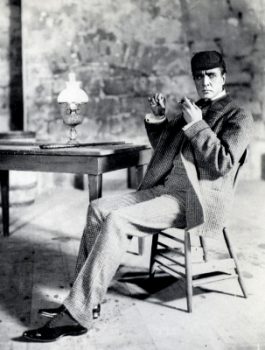The Public Life of Sherlock Holmes: Some Personalia About Sherlock Holmes (Doyle on Holmes)
 So in our first series post, we had a LONG post on ACD’s 1923 essay – The Truth Behind Sherlock Holmes – for Collier’s The National Weekly. This week, it’s an earlier one he which wrote for The Strand.
So in our first series post, we had a LONG post on ACD’s 1923 essay – The Truth Behind Sherlock Holmes – for Collier’s The National Weekly. This week, it’s an earlier one he which wrote for The Strand.
“The Adventure of the Dying Detective” ran in The Strand in December of 1913 (appearing the prior month over in America, in Collier’s). There wouldn’t be another Holmes story until September of 1917, with His Last Bow appearing in both The Strand, and Collier’s, that month.
Holmes having finally come back to his magazine with “The Dying Detective,” Strand editor Greenhough Smith was anxious to keep the detective’s name in the magazine. He persuaded Doyle to write an essay, Some Personalia About Sherlock Holmes, which ran in the December, 1917 issue. “The Adventure of the Mazarin Stone” wouldn’t follow until October of 1921.
I have this essay in Peter Haining’s The Final Adventures of Sherlock Holmes, from Barnes and Noble. Last week’s The Truth Behind Sherlock Holmes is also in that nifty book.
LETTERS
Doyle begins by talking about how many letters he has received regarding Holmes. He mentions many are in Russian. He does recount an amusing story of a woman in Warsaw (Poland) who states that she had been bedridden for two years and his novels “were her only, etc etc.”
That’s direct from the essay. I assume Doyle meant her only happiness, surcease from the pain, whatever. Then things take a fun twist.
“So touched was I by this flattering statement that I at once prepared an autographed parcel of them to complete the fair invalid’s collection.
By good luck, however, I met a brother author upon the same day to whom I recounted the touching incident. With a cynical smile, he drew an identical letter out of his pocket. His novels also had been for two years her only, etc etc. I do not know how many more the lady had written to, but if, as I imagine, her correspondence had extended to several countries, she must have amassed a rather interesting library.”
It’s Elementary – Richard Lancelyn edited the 1986 book, The Truth Behind Sherlock Holmes.
SIR SHERLOCK HOLMES
Next, he recounts that shortly after receiving his knighthood, he got a bill from a tradesman. It was legitimate and proper, except that it was made out to Sir Sherlock Holmes.
“I hope that I can stand a joke as well as my neighbors, but this particular piece of humor seemed rather misapplied, and I wrote sharply upon the repentant clerk, who expressed his sorrow at the incident.”
It’s Elementary – I never got the impression that Doyle had much of a sense of humor. Especially related to his writings, and Holmes. He seemed rather prickly.
The clerk told him that his mates had explained that when a man was knighted, he changed his name, and Doyle had taken Sir Sherlock Holmes. Doyle said that his annoyance vanished, and now he laughed at the whole thing.
THE PRIORY SCHOOL
In the essay posted last week, Doyle mentioned his mistake in this story. Here, he says that he has received twenty letters, from Labrador to Tibet, regarding Holmes’ deduction about bicycle tire tracks. Interestingly, in 1923 he admitted that his correspondents were correct and he was wrong. But back in 1917, he doubled down and explained why he was correct and the public was wrong. Maybe he mellowed with age.
MORE LETTERS
Doyle says that he gets autograph books from fans, asking for Holmes’ signature. And when he announced that Holmes was retiring to the Sussex Downs, people wrote him, offering to assist. One woman wondered if Holmes would be needing a housekeeper there at Christmas time.
It’s Elementary – ‘Martha’ is Holmes’ housekeeper in “His Last Bow.” Of course, there’s much speculation that Mrs. Hudson followed him from Baker Street.
DOYLE INVESTIGATES
 Next, he talks about being asked to look into crimes, just as his famous creation does. He was once offered money to go to Poland and look into an aristocratic murder. He declined, as he was not a professional sleuth. However:
Next, he talks about being asked to look into crimes, just as his famous creation does. He was once offered money to go to Poland and look into an aristocratic murder. He declined, as he was not a professional sleuth. However:
“… but I have several times as an amateur been happy to have been of some assistance to people in distress. I can say, though I touch wood as I say it, that I have never entirely failed in any attempt which I have made to reduce Holmes’s methods to practical use, save in one instance which I allude to later.”
He says that he can claim little credit regarding George Edalji; it being such an obvious miscarriage of justice.He refers to it as a disgrace to the country (nation).
It’s Elementary – I retold the Edjalji case for The MX Book of New Sherlock Holmes Stories series. You can read it free, online, here.
He then talks about the Oscar Slater case, which he says was a more complex one. Edalji was freed (though not pardoned or exonerated) after three years in prison. Slater was still imprisoned, when Doyle wrote:
“I have examined the evidence carefully, including the supplementary evidence given at the very limited and unsatisfactory commission appointed to inquire into the matter, and I have not the faintest doubt that the man is innocent. However, it is proverbially impossible to prove a negative, so there the matter must stand until the people of Scotland insist upon a real investigation into all the circumstances which surround this deplorable case.”
It’s Elementary – I also had Holmes look into the Slater case for The MX Book of New Sherlock Holmes Stories series. You’ll have to buy that volume to read that one.
THE TIRED CAPTAIN
Doyle then goes into some detail regarding an incident in which a man had disappeared. His relatives contacted Doyle a week later. Doyle applied Holmes’ methods and sent back a letter, stating that the man was either in Glasgow or Edinburgh. It turned out to be correct, though the man had already moved on.
It’s Elementary – I used this as the basis for my story, “The Adventure of the Tired Captain.” In that one, William Gilette plays Holmes while Doyle serves as his Watson, and they actually solve the case. You can read it free, online, here.
JAMES PHILLIMORE
Doyle self-deprecatingly mentions a crime a stones-throw from his house, which the local village constable solved. He had not gotten any further than identifying the culprit as a left-handed man with nails in his boots.I think that’s the ‘one exception’ he had referenced previously.
Then, he tells of an American case he heard about. It’s clearly the source of one of Watson’s best-known unchronicled cases. Several people have written pastiches about The Strange Disappearance of James Phillimore.
He follows that up with mention of another unsolved case.
THE CASE OF THE MYSTERIOUS CHALK
Doyle was entering a hall for an amateur billiard competition he was participating in. He was given a small packet, which someone had left there for him. He opened it and found a small piece of green chalk, of the type used in billiards.
He was amused and put it in his pocket. He actually used it during the game, and continued to do so afterwards. As he wrote:
“…Until one day some months later, as I rubbed the tip of my cue, the face of the chalk crumpled in, and I found it was hollow. From the recess thus exposed I drew out a small sip of paper with the words, ‘From Arsene Lupin to Sherlock Holmes.’ Imagine the state of mind of the joker who took such trouble to accomplish such a result.”
THE SNAKE RING
He then recounts a very weird letter he received that could have been a Conrad and Kirowan story from Robert E. Howard.
A Mrs. Seagrave (name made up) had been given a snake-shaped, dull, gold ring. One night she didn’t take it off, and she dreamt that:
“…she seemed to be pushing off some ferocious creature which fastened its teeth into her arm. On awakening the pain in the arm continued, and next day the imprint of a double set of teeth appeared upon the arm, with one tooth of the lower jaw missing. The marks were in the shape of blue-black bruises which had not broken the skin.
‘I do not know,’ says my correspondent, ‘what made me think the ring had anything to do with the matter, but I took a dislike to the ring and did not wear it for some months, when being on a visit, I took to wearing it again.’
To make a long story short, the same thing happened, and the lady settled the matter forever by dropping her ring into the hottest corner of the kitchen-range. This curious story, which I believe to be genuine, may not be as supernatural as it seems. It is well known that in some subjects a strong mental impression does produce a physical effect.Thus a very vivid nightmare-dream with the impression of a bite might conceivably produce the mark of a bite. Such cases are well attested in medical annals. The incident, would of course, arise by unconscious suggestion from the first.”
Doyle’s possible explanation amuses me. It very much strikes me as something Watson, with a degree of confidence, would give to Holmes as a potential solution. One Holmes would either immediately dismiss, or raise an eyebrow and ‘toy with Watson’ a bit.
A TREASURE MAP
 One letter to Holmes talked about an Indiaman which wrecked upon the South African coast in 1782, with a remarkable treasure aboard. Doyle wrote, “If I were a younger man I should be seriously inclined to go personally and look into the matter.”
One letter to Holmes talked about an Indiaman which wrecked upon the South African coast in 1782, with a remarkable treasure aboard. Doyle wrote, “If I were a younger man I should be seriously inclined to go personally and look into the matter.”
The letter came with a chart/map. Doyle believes part of the map utilizes that ship’s semaphore code, and perhaps some old papers at the India Office might explain them. Doyle conjectures about the map and the treasure’s location.
IN CLOSING
Doyle wraps up talking about Wlliam Gillette, whose stage play was a huge success in Europe and the US.
“One last word before I close these jottings about my imaginary character. It is not given to every man to see the child of his brain endowed with life through the genius of a great sympathetic artist, but that was my good fortune when Mr. Gilette turned his mind and his great talents to putting Holmes upon the stage. I cannot end my remarks more fittingly than by my thanks to the man who changed a creature of thin air into an absolutely convincing human being.”
So, that’s two interesting essays by Doyle related to his most famous creation.
DOYLE ON HOLMES
Doyle on Holmes: The Truth About Sherlock Holmes

 Bob Byrne’s ‘A (Black) Gat in the Hand’ made its Black Gate debut in 2018 and has returned every summer since.
Bob Byrne’s ‘A (Black) Gat in the Hand’ made its Black Gate debut in 2018 and has returned every summer since.
His ‘The Public Life of Sherlock Holmes’ column ran every Monday morning at Black Gate from March, 2014 through March, 2017. And he irregularly posts on Rex Stout’s gargantuan detective in ‘Nero Wolfe’s Brownstone.’ He is a member of the Praed Street Irregulars, founded www.SolarPons.com (the only website dedicated to the ‘Sherlock Holmes of Praed Street’) and blogs about Holmes and other mystery matters at Almost Holmes.
He organized Black Gate’s award-nominated ‘Discovering Robert E. Howard’ series, as well as the award-winning ‘Hither Came Conan’ series. Which is now part of THE DEFINITIVE guide to Conan. He also organized 2023’s ‘Talking Tolkien.’
He has contributed stories to The MX Book of New Sherlock Holmes Stories – Parts III, IV, V, VI, XXI, and XXXIII.
He has written introductions for Steeger Books, and appeared in several magazines, including Black Mask, Sherlock Holmes Mystery Magazine, The Strand Magazine, and Sherlock Magazine.